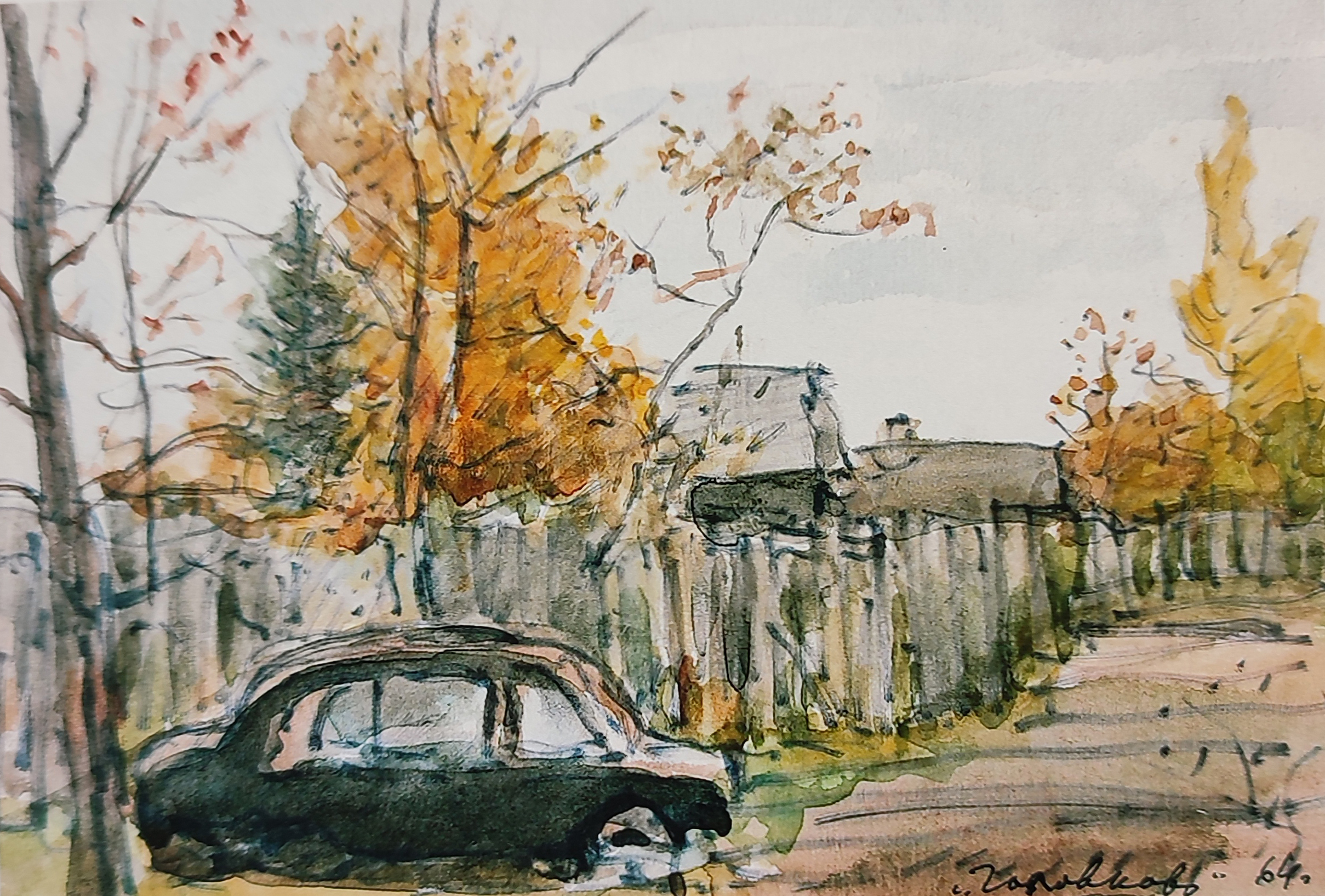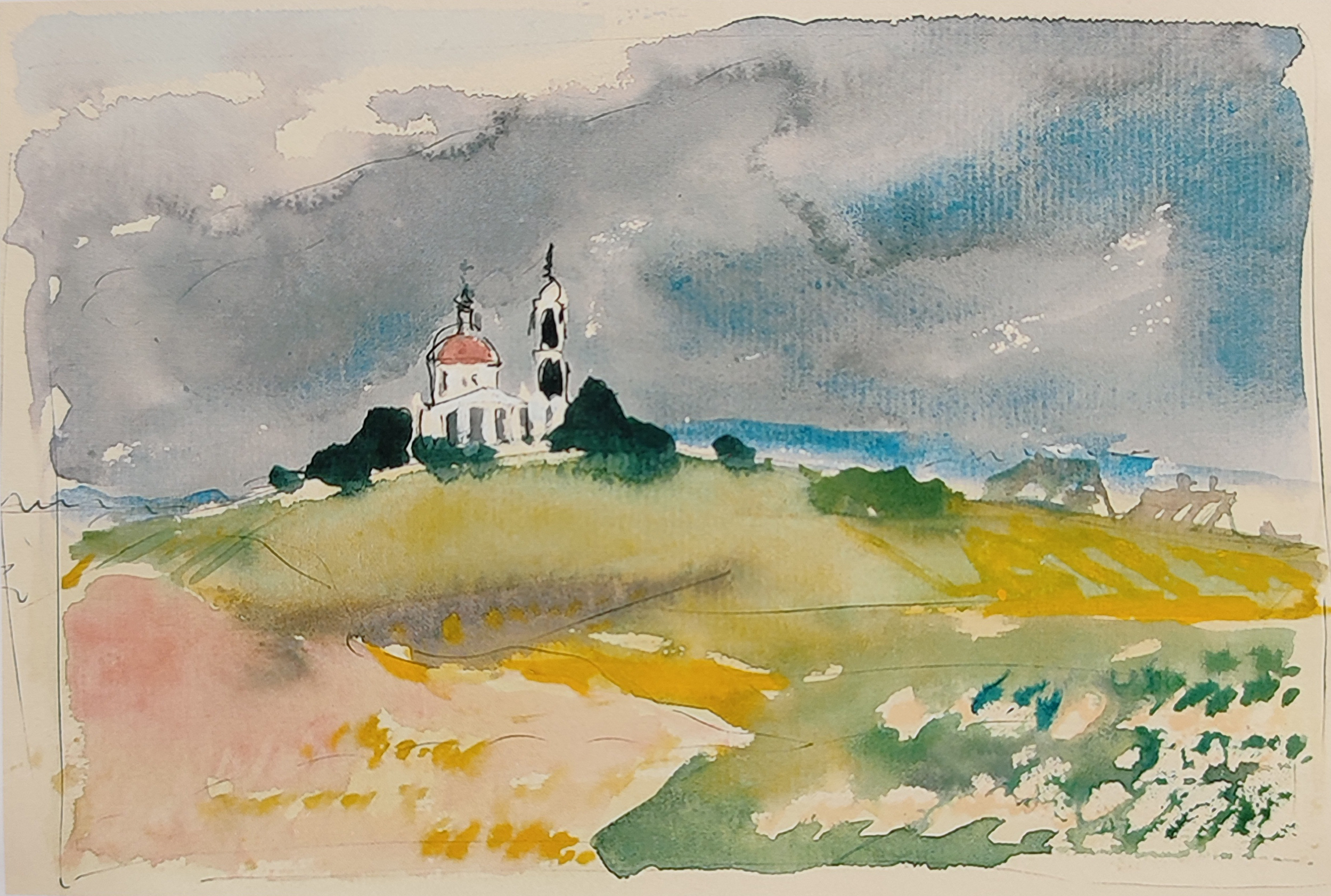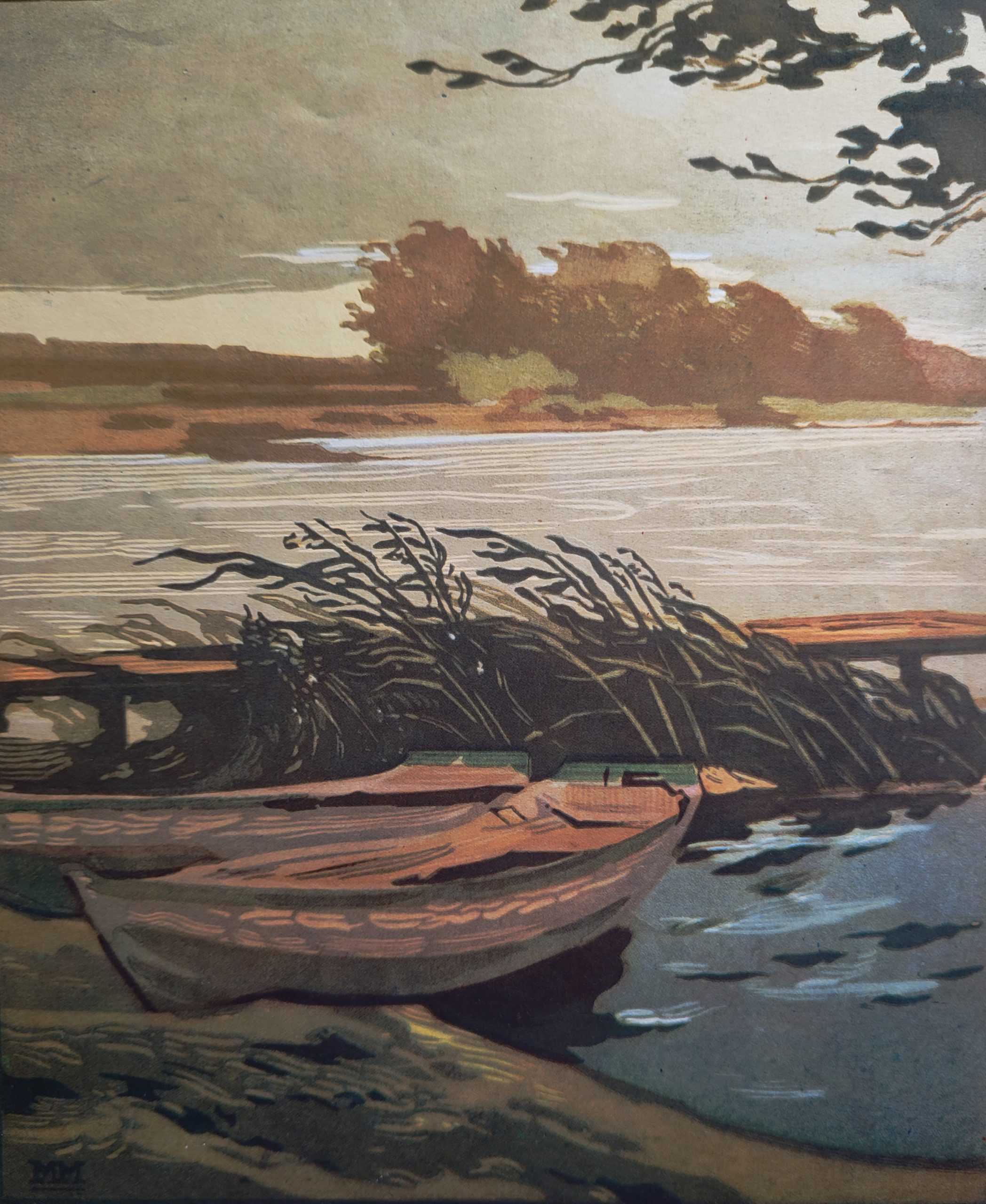Homeland – it is in the field, and on the pond, on the edge of mushrooms, in the August rain, in a good deed, in a pure thought
Alexey Shulgin
A station, a concrete road, the Church of the Intercession on a high hill blown by all the winds. Once again I visited Golovkovo, a nook where I spent my unassailable childhood. So many memories are associated with this village! What is so special about a village, since there are thousands of them in Russia? But everything is special!
What is Russia? How to understand patriotism? Through happy childhood. Now I especially remember haymaking time, a harvesting period (maybe because fields in Golovkovo are not sown). They were no longer mowed with scythes, but with the machines. After a day or two the field was cleared. Only huge hills of hay rose three or four meters high. Experiencing fear and delight at the same time, we climbed on the very top and then rolled down. High summer, the redolent smell of cut grass.
Recently I saw haymaking depicted by V. M. Sidorov, and everything came to life in my memory: a distant, irrevocable time. Plowing is also memorable: one or two tractors move smoothly across the field with smoking chimneys, these are the Kirovets giants; behind the plow, there are dozens of gulls and rooks flying. They enjoy a feast. And you stand and look at the arable land, as the earth, just torn up with a metal blade, darkens. When the land-nurse warms up in the sun, sometimes you can see how steam rises to the sky, barely noticeable. Soon the collective farmers will sow fields with rye or potatoes, peas or sunflowers, or wild grasses will rise (if the field is allowed to rest for a year).
I remember once we met a bearded man on a forest road, and my parents, talking quietly, repeated: “Nikonenko”. The actor lived and worked on the role in Golovkovo. Porfiry Krylov (one of the Kukryniksy), who painted a village street, also was thrown into Golovkovo. I look at his picture and recognise the houses.

The Church of the Intercession of the Holy Virgin. As I read in one historical work: “… Peasants from the villages of Voznesensky and Borshchevo were resettled to the wasteland of Shilov near the churchyard, so appeared the village of Golovkovo”. The wooden church in the name of the Intercession of the Holy Virgin appeared in the 1720s. In the 1730s two ponds were dug, wooden mansions erected for the Archbishop of Tver, and the apple orchard planted. In 1856, according to the project of the architect Bykovsky, the construction of a new stone church began. In 1864 the temple was consecrated.
I remember the church in Golovkovo ruined. As boys, we used to head to the stone giant on bicycles, with bated breath we made our way inside, and it was always gloomy and cool there. Pigeons cooed under the dome. Logs laid on the ground, there were no floors. The miraculously preserved murals surprised me for the rest of my life. These images of ancient saints touched the boyish soul. I really wanted to climb on the bell tower, but the stairs rotted and collapsed. Linden leaves rustled behind the windows. Lindens were partially cut down during the restoration of the church. The old murals were painted over and redrawn. But I remember them. The famous artist T. A. Mavrina immortalised the church in Golovkovo and the landscape, which has changed significantly by today. Mavrina said very accurately about the beauty of the Moscow region: “Landscape after landscape. A continuous sequence of landscapes, if the day is to your liking. Where to catch the eye? Our Moscow suburbs with small rivers, shallow ravines, low ridges, are so beautiful!
I also remember the source of the Istra river. “Two streams, originating in a swamp near the village of Koskovo, merge to form a narrow river with a clearly defined channel and a noticeable stream”, writes Tatyana Alekseevna. “Not far from the place of their confluence, on an elevated bank in the village of Golovkovo, there is a church …”
I remember the Istra reservoir near Krivtsovo, boats thrown ashore, which seemed to me to be steamboats. We swam in the Istra, across which two logs were thrown as a bridge, and hardly there were places deeper than a metre, we also did not find any whirlpools. Clean and cold Istra. On the other side were the fields sown with sunflowers and corn. Now it looks different: instead of fields – dachas, dachas, dachas. Recently my older brother asked: “Do you think I can walk along the Istra from Laptevo to Solnechnogorsk?” I doubted very much: the channel became too overgrown, the banks too overbuilt, it was impossible to pass. And in my memory, I am still splashing in the Istra waters, and firs rise above my head.
The surroundings of Solnechnogorsk are rich in memorable places and names. Another village is Chepchikha near the Senezh station. In the 19th century, here was the estate owned by the grandmother of the poet Apollon Maykov, who used to live in Chepchikha and wrote:
The pictures of the poor midnight countryside!
Wherever I die, I will remember you when I die;
Driving away all evil from a full heart,
Were it you who taught me how to live in peace with people.
And another poem by Apollon Nikolaevich includes the following line: “I began to remember myself in a village near Moscow”.
The estate has not been preserved, but the man-made ponds still remain in the old park. I remember how the visitors of the holiday centre rode boats on the pond. Now the holiday centre is closed, and it is impossible to get into the territory of Maykov’s estate. It was pleasant to walk in the park along the earthen paths generously covered with needles. Behind the trees, the Leningrad highway was noisy.
Senezh is a natural wonder! There are two interesting stories to read in an old 1958 book, The Angler. “The Senezh Lake, located 60 kilometres far from Moscow and two kilometres far from the Podsolnechnaya station of the Oktyabr railway, was formed as a result of the construction of an earthen dam built in the valley of the Sestra and Mazikha rivers. Previously, there was a small lake with an area of about 80 hectares, on the site of the current part of the lake known as the Old Senezh. The emergence of the Senezh Lake is attributed to 1825. The creation of this artificial reservoir is associated with the construction of a water system to connect the Volga with Moscow through the Dubna – Sestra – Istra river system. For this, a connecting canal was built between the upper reaches of the Sestra and Istra rivers, which can still be seen in Solnechnogorsk, as well as on the Istra reservoir near Krivtsovo and Mirontsevo”… Reading this is like looking at and “travelling” by a geographical map, it is breathtaking!

Tsar Peter the Great planned to connect Moscow with the Volga in 1722. Engineer Georg Wilhelm de Gennin prepared a project for the Russian autocrat in three versions. But the project was put off for a hundred years. They dug a canal, straightened the Istra, built thirteen stone locks. And in 1844 barge haulers went along the shores of Moscow region, pulling barges with commodities. However, the newly built Nikolaev railway depreciated the brand new waterway. They stopped carrying goods by water, the canals became silted up and overgrown. They were soon abandoned. How ironic fate is, how history is somewhat reminiscent of a mirror …
“Ah, Senezh, my Senezh”, I will drawl out, almost repeating the bard. There was a time! The famous Russian zoologist and fisherman L. P. Sabaneev (1882) mentioned huge crucian carps of the Senezh weighting 4–5 kilograms, in his book Fishes of Russia. We didn’t catch giant crucian carps, but my older brother caught fish in the lake and hunted even more crayfish until the shores were covered with sand, heaping up the beaches.
I recently made a discovery for myself: how many artists painted my Senezh! And the artists are amazing. M. V. Matorin, one of the best engravers, repeatedly came and worked on the Senezh. I consider his landscape with boats as one of the best masterpieces. Many works were created by artists, but seeing is believing.
Having already lived on this earth, I got to Tarakanovo, Shakhmatovo, Boblovo, finally seeing Blok’s estates. I still consider Alexander Alexandrovich Blok as my neighbour and countryman. With trepidation I take books of his poems and read:
A full moon rose over the meadow
As as unchanging wondrous circle,
It shines and it is silent.
A pale, pale meadow is blooming,
The darkness of the night, creeping over it,
Is resting, sleeping.
The images are so familiar and dear … The view of the spruce forest, the jagged skyline (a fabulous ornament!) still delight me. Every time a fairy tale begins with these spruce escallops. It is a pity that the forest near Golovkovo has grown decrepit and was cut down. I can not take buildings and fences now. Where there was an open field – now there are gardeners’ partnerships. But the historical landscape is the property of the people. How to explain then to grandchildren what free rein is, what wide open space is, if they see life from behind a fence?

However, the animals in the zoo do not need freedom. Maybe a person is such an “animal in captivity”? No, I can’t get used to it; A. S. Pushkin, A. K. Tolstoy, N. A. Nekrasov, F. I. Tyutchev did not teach that. Homeland – it is in the field, and on the pond, on the edge of mushrooms, in the August rain, in a good deed, in a pure thought.
My heart pulsates in my chest in anticipation that in thirty minutes the bus will take me to Ozhogino or Tarakanovo.
My native land, you remain native even when unrecognisable. The forest has grown decrepit, partially cut down, but even after forty years I know how to get to the mushroom fields or the old Kvashnino road, where, in my memory, cattle were driven from Kvashnino to Golovkovo. How beautiful were the fields sown with peas near Subbotino! As boys, we raided them, when the watchman might be angry. I knew many villagers: I remember how a crooked, fat peasant transported manure on a cart. Once, in bad weather, his horse pulled a car out of the mud. In Laptevo, behind the vegetable gardens, there was a stable. None of the old village acquaintances is alive, and the landscape has changed since then. But why does the soul hurt and pull me to the native ashes?
I wanted love for our small homeland not to leave us, like a parental blessing. This is the only way to retain happiness …




